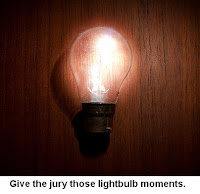The above quote from Aristotle
(384-322 B.C.) is the Tao of visual communication.
It has been a while since I posted here. Returning to law firm life has kept me very busy the last eight months. Additionally my self-imposed writers block prevents me from publishing unless the content is substantive. I abhor bloggers who post one paragraph or a random thought – that just adds to my impending carpal tunnel generated by gratuitous clicking through rubbish.
Anyway I just completed a trial in
Philadelphia and witnessed (no pun intended) a stunning example of visual
communication at play. It inspired me to return to this blog and write a tad
about my experience. For background our case had a voluminous amount of data to
the sum of several hundred thousand pages. There were many parties involved and
it was a bench trial much to the dismay of plaintiff’s counsel.
Our
judge was an elderly but scholarly man who was interested in the facts and not
a side show. Therefore we had the task of being very on point with our
witnesses’ examinations and presentation of evidence. In any trial the lawyers
are generally
constrained by time and in a bench trial this is a heightened concern. During
pre-trial meetings it was very apparent that our judge would NOT allow minutiae
or argument too many times.
 Our setup in the courtroom was the
standard projector, screen and monitors for all counsel. Since we had no jury
we took advantage of the jury box and setup the screen there. This proved
beneficial later because it was so close to the judge’s bench.
Our setup in the courtroom was the
standard projector, screen and monitors for all counsel. Since we had no jury
we took advantage of the jury box and setup the screen there. This proved
beneficial later because it was so close to the judge’s bench.
During
opening statements it became clear to me and the rest of our case team that the
judge was responding to our exhibits positively. Plaintiff’s counsel presented
evidence with Trial Director (as did our team) and spent time constructing many
multi-tier callouts from deposition testimony. In a jury trial these would have
been nice but I think it was a tactical mistake in this bench proceeding. Each
except of testimony had a two page leader, e.g. announcement of the deponent
and then the full page of transcript before the callout was finally published.
In
a time constrained opening this method was not only a flow killer but not
terribly easy for the judge to follow. The text ubiquity
had the judge sagging in his chair not even minding the screen or his monitor
after the first ten minutes. When it
comes to quick communication techniques the adage goes, pictures are worth a
thousand words, and often much more. Visuals
usually are the best communicators and in this trial they proved attention
grabbing and persuasive.
For our opening we immediately went
to the most compelling photographs of the entire case. We intertwined this was some quick video snippets and interactive
flash documents. The judge was not only listening to our lead trial
attorney but was paying attention to every exhibit. This in turn was the theme
of our entire presentation throughout the trial. In retrospect considering our
trial was estimated to last multiple weeks this strategy would have worked well
with a jury.
Text competes with the trial attorney because the jury cannot listen while they’re reading a screen or monitor. Instead communicating visually and orally as often as possible takes the BORING out of any presentation. Obviously in a document intensive case we cannot possibly avoid showing text to a judge or jury. And in no way am I suggesting that visual communication techniques are a perfect replacement for required text exhibits. Instead I encourage any reader of this blog to be creative in their use of interactive/multi-media, photographs, video and custom presentations.
Know
your audience – or at the end of the trial they might know nothing about your
case.












